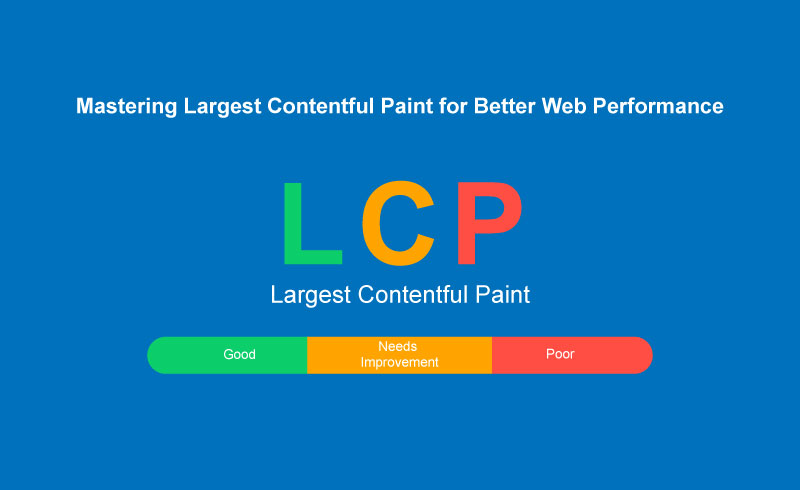Everything About Core Web Vitals



In web design and SEO, Google Core Web Vitals are crucial. These metrics, set by Google, assess the actual user experience of web pages with an emphasis on three main areas: loading speed, interactivity, and visual stability. It’s important to understand and improve these metrics to boost both user satisfaction and search engine visibility.
Key takeaway: Focusing on Core Web Vitals Google can greatly improve user experience and your website’s search engine rankings. By prioritizing metrics such as Largest Contentful Paint (LCP), First Input Delay (FID), and Cumulative Layout Shift (CLS), you can ensure that your site provides a smooth and captivating experience for visitors while also benefiting from better SEO performance.
Understanding Core Web Vitals
Largest Contentful Paint (LCP)
Largest Contentful Paint (LCP) measures the time it takes for the largest content element on a web page to become visible in the viewport. It is a significant factor in loading performance and directly influences users’ perception of speed.
Why LCP Matters?
- Loading Performance: Users expect fast-loading websites. A slow LCP can lead to frustration and increased bounce rates.
- User Experience: A quick LCP ensures that the main content is promptly visible, enhancing user satisfaction.
Ideal LCP Score
An optimal LCP score should be under 2.5 seconds. Here’s why:
- Under 2.5 Seconds: Indicates good performance, leading to higher user engagement and retention.
- Between 2.5 and 4 Seconds: Needs improvement; users might start feeling the website is slow.
- Above 4 Seconds: Poor performance, likely causing high bounce rates.
Achieving an Optimal LCP Score
To achieve an LCP score under 2.5 seconds, consider these optimization techniques:
Optimize Images
- Compress images using tools like TinyPNG or ImageOptim.
- Use modern image formats like WebP.
- Implement responsive images with srcset.
Improve Server Response Time
- Utilize faster hosting services.
- Implement a Content Delivery Network (CDN) to reduce latency.
- Cache assets effectively.
Minimize Render-Blocking Resources
- Defer non-critical JavaScript using the defer attribute.
- Inline critical CSS.
- Load CSS asynchronously.
Remove Unused Third-Party Scripts
- Audit third-party scripts and remove those that are unnecessary.
- Load third-party scripts asynchronously.
Preload Important Resources
- Use <link rel=”preload”> to prioritize important assets such as fonts and hero images.
Optimize CSS
- Minify CSS files to reduce size.
- Use critical CSS to load above-the-fold content faster.
Reduce JavaScript Execution Time
- Minify and compress JavaScript files.
- Split long tasks using requestAnimationFrame or setTimeout.
By focusing on these strategies, you can significantly improve your site’s LCP score, ensuring a better user experience and potentially boosting your search engine rankings.
First Input Delay (FID)
First Input Delay (FID) measures interactivity, capturing the time from when a user first interacts with a web page to the moment the browser responds to that interaction. This metric is crucial for user engagement as it reflects how quickly users can interact with your site, impacting their overall experience.
Role of FID in Measuring Interactivity
- Interactivity: FID gauges how responsive a site is to user inputs like clicks, taps, or key presses. A delay here can frustrate users and lead to higher bounce rates.
- User Engagement: Quick responses to user interactions enhance engagement levels, making users more likely to stay on the site and explore further.
Common Causes of Poor FID Scores
1. Heavy JavaScript Execution:
- Large JavaScript bundles can block the main thread, delaying response times.
- Heavy computations during page load can slow down interactivity.
2. Long Tasks:
- Tasks exceeding 50 milliseconds on the main thread can cause significant delays.
- These tasks prevent the browser from responding promptly to user inputs.
3. Unoptimized Third-Party Code:
- External scripts from ads, analytics, or social media widgets often contribute to delays.
- Third-party code can be unpredictable and hard to control but has a notable impact on FID.
Effective Strategies to Improve FID
- Code Splitting: Break up large JavaScript bundles into smaller chunks that can be loaded asynchronously.
- Minimize Main Thread Work: Optimize scripts and stylesheets to reduce the workload on the main thread.
- Defer Non-Critical Scripts: Use techniques like async and defer for non-essential scripts to prevent them from blocking the main thread during page load.
- Optimize Third-Party Scripts: Limit third-party script usage or load them after critical content has initialized.
Prioritizing these strategies ensures lower FID scores, enhancing both user satisfaction and SEO performance.
Cumulative Layout Shift (CLS)
Cumulative Layout Shift (CLS) is a metric focused on visual stability during web page load time. Unlike LCP and FID, which measure loading performance and interactivity, CLS gauges how often users experience unexpected layout shifts. These shifts can be frustrating, causing users to click on the wrong elements or lose their place while reading.
Significance of CLS
Maintaining visual stability is crucial for a smooth user experience. Websites with high CLS scores tend to have elements that move around as the page loads, leading to a disjointed and confusing browsing experience. This can significantly impact user satisfaction and retention rates.
Practical Tips to Minimize Layout Shifts
To achieve a stable visual experience:
- Always include size attributes for images and videos: Define width and height in your HTML or CSS to ensure the browser allocates the correct space while loading the media.
- Avoid inserting content above existing content: When ads or other dynamic content are loaded, ensure they don’t push down existing elements on the page.
- Use transform animations over layout-changing animations: CSS properties like transform are more efficient than properties that trigger layout recalculations.
- Preload fonts: Use the font-display: optional; property to prevent text from shifting when web fonts load.
- Reserve space for ads and embeds: Allocate specific areas for ads and embedded content to prevent them from causing shifts when they load asynchronously.
By focusing on these strategies, you can maintain visual stability, ensuring that your users enjoy a seamless browsing experience free of unexpected disruptions.
The Impact of Core Web Vitals on SEO Rankings
Google considers Core Web Vitals as crucial ranking factors in its search engine algorithms. These metrics—Largest Contentful Paint (LCP), First Input Delay (FID), and Cumulative Layout Shift (CLS)—reflect the real-world user experience, directly influencing your website’s visibility in search results.
Key Influences on SEO Rankings
- Search Engine Optimization (SEO): Google’s emphasis on user experience means that websites with better Core Web Vitals assessment are more likely to achieve higher rankings. This prioritization ensures that users find the most relevant and user-friendly content.
- User Engagement Metrics: Improved Core Vitals scores correlate with enhanced user engagement metrics. These good vitals can generate more effective content.
- Lower Bounce Rates: Good web vitals can give faster loading times and stable visual elements reduce the likelihood of users leaving your site prematurely.
- Longer Session Durations: Google web vitals enhance better interactivity and visual stability encouraging users to spend more time exploring your content.
Why It Matters:
By focusing on optimizing Core Website Vitals, you not only improve your site’s performance but also align with Google’s ranking criteria.
- Enhanced user experience leads to better retention, engagement, and ultimately, higher conversion rates.
- Ensuring that your website meets the standards set by Core Web Vitals metrics is essential for maintaining competitive edge in search engine rankings and providing a superior browsing experience for your audience.
Tools to Measure and Optimize Core Web Vitals Performance
Understanding and optimizing Core Web Vitals is crucial for improving your website’s performance and user experience. Various tools are available to help measure and enhance these metrics:
Google Page Speed Insights
Google PageSpeed Insights provides insights into a site’s performance on both mobile and desktop devices. It offers detailed reports on each Core Web Vitals test, including:
- Largest Contentful Paint (LCP)
- First Input Delay (FID)
- Cumulative Layout Shift (CLS)
By analyzing these metrics, the tool provides suggestions for improvements to help you achieve better scores.
Chrome User Experience Report
The Chrome User Experience Report (CrUX) collects real user measurement data from millions of websites. This tool offers:
- Aggregate performance metrics from real-world Chrome users.
- Data on how users experience your site in different environments.
Google Search Console’s Core Web Vitals Report
Using the Core Web Vitals report in Google Search Console can give you valuable insights into your website’s performance. Here’s a step-by-step guide:
- Navigate to the Core Web Vitals Report: Log in to your Google Search Console account and find the “Core Web Vitals” section under “Enhancements.”
- Review Your Site’s Performance: The report displays URLs grouped by their status (Poor, Needs Improvement, Good).
- Identify Issues: Click on a specific URL group to see detailed information about the issues affecting LCP, FID, or CLS.
- Follow Recommendations: Implement the suggested improvements provided by Google to enhance your Core Web Vitals scores.
By regularly monitoring these tools, you can stay informed about your website’s performance and make necessary adjustments to optimize it effectively.
Best Practices for Optimizing Your Website’s Core Web Vitals Scores
Implementing website performance optimization and user experience strategies can significantly enhance your Web Core Vitals scores. Here are some actionable tips:
Improving Largest Contentful Paint (LCP)
- Optimize Images: Compress images and use next-gen formats like WebP.
- Server Response Time: Reduce server response times by using faster hosting services and optimizing your database.
- Critical CSS: Inline critical CSS to reduce render-blocking resources while analyzing speed core.
- Resource Prioritization: Load important resources first, such as above-the-fold content.
Enhancing First Input Delay (FID)
- Minimize JavaScript Execution: Break up long tasks and defer unused JavaScript.
- Web Workers: Utilize web workers to handle complex scripts off the main thread.
- Input Readiness: Ensure the browser responds quickly to user interactions by reducing the amount of work on the main thread.
Reducing Cumulative Layout Shift (CLS)
- Set Size Attributes for Media: Always include width and height attributes on images and videos to prevent layout shifts.
- Ad Space Reservations: Allocate space for ads and embeds to avoid unexpected shifts.
- Avoid Inserting Content Above Existing Content: Add new UI elements below the fold or in a predictable manner.
Importance of Mobile Optimization
Given that a significant portion of web traffic comes from mobile devices:
- Responsive Design: Ensure your website is fully responsive, adapting smoothly to different screen sizes.
- Mobile-Specific Resources: Serve optimized resources tailored to mobile devices, such as smaller images and streamlined scripts.
Role of Content Delivery Networks (CDNs)
CDNs play a crucial role in enhancing performance:
- Global Distribution: Distribute content across multiple servers worldwide to reduce latency.
- Caching Static Assets: Cache static assets like images, stylesheets, and scripts to speed up load times.
Focusing on these best practices will not only improve your Core Web Vitals scores but also elevate the overall user experience of your website.
Conclusion
Prioritizing user experience in web development strategies is essential, especially as Corewebvitals continues to evolve as a standard measure. Staying updated with future trends in web performance ensures that your website remains competitive.
Focusing on these metrics’ benefits both users and search engines with enhanced user satisfaction and SEO advantages can yield better results. Higher Core Web Vitals scores can lead to better search engine rankings, resulting in increased visibility and traffic. Emphasize user-centric performance metrics to achieve long-term success and maintain an edge in an ever-evolving digital landscape.